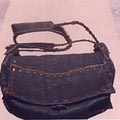The original inhabitants of Darjeeling are the Lepchas, with people from neighbouring Nepal, Bhutan, Sikkim, and Tibet, as well as from the plains of West Bengal and Bihar also there. The forested foothills are peopled by the semi-tribal rajbanshis and ravas of the north Bengal plains, mundari cultivators from the Chota Nagpur hills, and modesias who are descendants of the mixed tea-garden labour. The tea-garden workers are a mix of tribals from Chota Nagpur and Central India, people of surrounding hill regions, mainly Nepalis, and people from the plains of Bengal and Bihar.
Bamboo, cane, and forest creepers are used efficiently by the hill inhabitants of West Bengal to make deep and shallow baskets of different kinds for domestic uses, beautifully shaped and intricately woven dowry boxes, and a large variety of fishing traps and cages for birds and animals. Bamboo is also used to make ceremonial vases for which bamboo with a wide diameter — chhaya bans — is used. Date and other palm leaves and grasses are used to weave mats. Another fine example of hill crafts is the intricately crafted mask made of khankpa wood which is used for ritual dances
In the Chota Nagpur area, specially designed fabrics and agricultural and household implements made of iron and steel are made by weavers and blacksmiths respectively. Silver smiths and coppers miths who make exquisitely designed ornaments for tribal women also live among the tribals. Non-tribal craftspeople of Midnapore and Bankura districts also make the bell-metal and brass utensils used by the hill tribals.
The handicrafts of Darjeeling are quite distinct from the crafts prevailing in the rest of West Bengal and express the cultural heritage of Buddhism prevailing in the eastern Himalayas. Bhutia basti or the Bhutia settlement or village has been built over the last 150 years, and is the home of craftspersons, painters, musicians, and traditional scholars who represent the whole of the folk cultures of the hill people of the eastern Himalayas. Hill craftspersons know and practise a number of crafts at the same time. The traditional hill craftsmen make the sculptural model for a bronze figure directly with wax for each individual bronze figure. The modelling of the figure is hollow, made of sheets of pliable wax, where the thickness of the sheets is determined by the desired thickness of the hollow bronze figure. A soft core mixture is poured inside to solidify and dry. The wax model is finished in detail before covering it with moulding materials of layers of clay mixtures of different compositions. Once this is dry the figure is cast. The wax layer melts leaving behind the perfectly chiselled metal figure.
At Bhutia basti, both chemical dye stuffs as well as indigenously prepared vegetable dyes are used to colour the cloth. Traditional paintings by painters of the Bhutia basti depict themes from the Buddhist Jataka stories as well as from Buddhist scriptures. These are made in a scroll on handmade paper from Tibet and Nepal and mounted on cloth. The paintings are called thankas and are in the tempera technique, using finely ground stone and earth colours. Lapis lazuli, a blue stone colour, is obtained by grinding semi-precious stones from Tibet. The thanka is bordered with fine brocade having Buddhist motifs, especially made for this purpose at Varanasi. Thanka painters sometimes use gold leaf or powder to embellish their paintings. The process of applying gold on a thanka is very expensive and is a closely guarded secret. The painted scrolls are used in household shrines in all Buddhist homes among Nepali, Sikkimi, Bhutia, and Tibetan people, as well as in monasteries. Kalimpong in the Darjeeling district — where a number of Nepali and Bhutia craftspersons live — is on the trade route between India and Nepal. The crafts here were originally for colonial rulers, an example being embroidered knee-boots; these crafts are becoming very rare now. Bhutia artisans make beautifully shaped metal containers set with semi-precious stones.
Kalimpong is also a centre for Tibetan carpets. Wool is spun by the Tibetan women of Darjeeling on a traditional spinning wheel called the chassba; they spin the wool continuously chanting the mantra, Om mani padme hum. The carpets woven by the Bhutia weavers have geometrical motifs, using blocks of colour to build them up. The loom has two vertical wooden beams with fixed pegs at the top and bottom, while two horizontal beams carry the warp threads of cotton tied to each other. The knotting is done by looping the thread around the warp and the rod which is used for looping is placed horizontally and at right angles to the warp. When a motif or other colours have to be introduced, the ground colour is cut and a new thread is inserted by twisting into a single warp thread and looping. A three ply twisted wool is thrown across to be used as a weft. The weaving is mainly done by women.
The most common type of carpet is the small bedside carpet known as duns which has 60 knots to a square inch. Squares to sit on are called as asans. The motifs used are alpana designs, which are usually drawn on floors for festive occasions, geometrical patterns, floral designs, and some Tibetan symbols like the mythical birds called dak, jira the dragon, the lion, and the god of lightning, represented by a zig-zag line. Central Asian influence is seen in the key and swastika designs. The latter is curled instead of angular. Initially the weaving was done mainly in cotton but now woollen carpets are being woven. The Tibetan Refugees’ Self Help Centre is mainly involved in this craft; the carpets made are up to 40 knots per square inch.
Thematic interpretations of various elements in Tibetan iconography are woven in. The colour of the background is restrained but the design are in bold colours. The motifs include the dak goh or staring dragon, the pema gyaja which is a lotus and bird combination, or the pema thang tsi gumpo which is a lotus and bat combination. Gyaja thang medok is a bird and flower design whereas nehtsho thang medok is a parrot and flower combination. Other motifs include flowers in the field, broken borders of flowers and swastikas alternating, and the ganachari or Wall of China. A ‘V’-shaped cut is made along the edges of the design to give relief to the parts of the design and thus to delineate it from the background.


